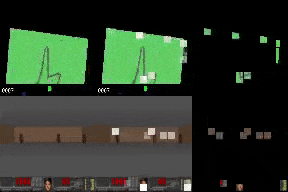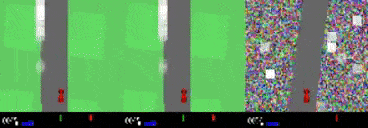Use ==/!= to compare str, bytes, and int literals because identity is not the same thing as equality in Python. These instances will raise a SyntaxWarning on Python >= 3.8 so it is best to fix them now. https://docs.python.org/3.8/whatsnew/3.8.html#porting-to-python-3-8
./WANNRelease/prettyNeatWann/neat_train.py:58:6: F632 use ==/!= to compare str, bytes, and int literals
if (gen%hyp['save_mod']) is 0:
^
./WANNRelease/prettyNeatWann/wann_train.py:58:6: F632 use ==/!= to compare str, bytes, and int literals
if (gen%hyp['save_mod']) is 0:
^
./WANNRelease/prettyNeatWann/domain/make_env.py:62:5: F821 undefined name 'domain'
domain.seed(seed)
^
./WANNRelease/prettyNeatWann/utils/utils.py:67:6: F632 use ==/!= to compare str, bytes, and int literals
if sum(ratio) is not 1:
^
./WANNRelease/prettyNeatWann/utils/utils.py:96:7: F632 use ==/!= to compare str, bytes, and int literals
if (len(A) is 0) or (len(B) is 0):
^
./WANNRelease/prettyNeatWann/utils/utils.py:96:24: F632 use ==/!= to compare str, bytes, and int literals
if (len(A) is 0) or (len(B) is 0):
^
./WANNRelease/prettyNeatWann/neat_src/neat_dataGatherer.py:46:8: F632 use ==/!= to compare str, bytes, and int literals
if len(self.x_scale) is 0:
^
./WANNRelease/prettyNeatWann/neat_src/neat_dataGatherer.py:55:8: F632 use ==/!= to compare str, bytes, and int literals
if len(self.best) is 0:
^
./WANNRelease/prettyNeatWann/neat_src/wann_ind.py:124:8: F632 use ==/!= to compare str, bytes, and int literals
if choice is 1:
^
./WANNRelease/prettyNeatWann/neat_src/wann_ind.py:128:10: F632 use ==/!= to compare str, bytes, and int literals
elif choice is 2:
^
./WANNRelease/prettyNeatWann/neat_src/wann_ind.py:132:10: F632 use ==/!= to compare str, bytes, and int literals
elif choice is 3:
^
./WANNRelease/prettyNeatWann/neat_src/wann_ind.py:139:10: F632 use ==/!= to compare str, bytes, and int literals
elif choice is 4:
^
./WANNRelease/prettyNeatWann/neat_src/wann_dataGatherer.py:42:8: F632 use ==/!= to compare str, bytes, and int literals
if len(self.x_scale) is 0:
^
./WANNRelease/prettyNeatWann/neat_src/wann_dataGatherer.py:51:8: F632 use ==/!= to compare str, bytes, and int literals
if len(self.best) is 0:
^
./WANNRelease/WANN/wann_train.py:57:6: F632 use ==/!= to compare str, bytes, and int literals
if (gen%hyp['save_mod']) is 0:
^
./WANNRelease/WANN/wann_src/dataGatherer.py:42:8: F632 use ==/!= to compare str, bytes, and int literals
if len(self.x_scale) is 0:
^
./WANNRelease/WANN/wann_src/dataGatherer.py:51:8: F632 use ==/!= to compare str, bytes, and int literals
if len(self.best) is 0:
^
./WANNRelease/WANN/wann_src/_variation.py:352:6: F632 use ==/!= to compare str, bytes, and int literals
if choice is 1:
^
./WANNRelease/WANN/wann_src/_variation.py:356:8: F632 use ==/!= to compare str, bytes, and int literals
elif choice is 2:
^
./WANNRelease/WANN/wann_src/_variation.py:360:8: F632 use ==/!= to compare str, bytes, and int literals
elif choice is 3:
^
./WANNRelease/WANN/wann_src/_variation.py:367:8: F632 use ==/!= to compare str, bytes, and int literals
elif choice is 4:
^
./WANNRelease/WANN/domain/make_env.py:58:5: F821 undefined name 'domain'
domain.seed(seed)
^
./WANNRelease/prettyNEAT/neat_train.py:58:6: F632 use ==/!= to compare str, bytes, and int literals
if (gen%hyp['save_mod']) is 0:
^
./WANNRelease/prettyNEAT/domain/make_env.py:61:5: F821 undefined name 'domain'
domain.seed(seed)
^
./WANNRelease/prettyNEAT/utils/utils.py:67:6: F632 use ==/!= to compare str, bytes, and int literals
if sum(ratio) is not 1:
^
./WANNRelease/prettyNEAT/utils/utils.py:96:7: F632 use ==/!= to compare str, bytes, and int literals
if (len(A) is 0) or (len(B) is 0):
^
./WANNRelease/prettyNEAT/utils/utils.py:96:24: F632 use ==/!= to compare str, bytes, and int literals
if (len(A) is 0) or (len(B) is 0):
^
./WANNRelease/prettyNEAT/neat_src/dataGatherer.py:46:8: F632 use ==/!= to compare str, bytes, and int literals
if len(self.x_scale) is 0:
^
./WANNRelease/prettyNEAT/neat_src/dataGatherer.py:55:8: F632 use ==/!= to compare str, bytes, and int literals
if len(self.best) is 0:
^
./WANNRelease/vae/vae.py:9:30: F821 undefined name 'sess'
if 'sess' in globals() and sess:
^
./WANNRelease/vae/vae.py:10:5: F821 undefined name 'sess'
sess.close()
^
26 F632 use ==/!= to compare str, bytes, and int literals
5 F821 undefined name 'domain'
31













